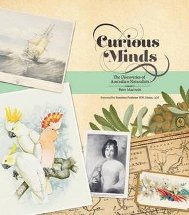Curious Minds: The Discoveries of Australian Naturalists by Peter Macinnis

National Library of Australia, 2012. Pbk., RRP SA39.99. ISBN
9780642277541.
Australia's unique flora and fauna fascinated our early European
visitors who took home tales of strange and curious creatures that
could surely only be the product of an over-active imagination or
too many days at sea under an unfamiliar hot sun. Perhaps being down
under did something strange to their eyes and brains! So naturalists
became an essential part of the passenger lists of explorers so
these weird and wonderful things could be documented through
drawings, descriptions and specimens. Names like Banks, Dampier and
Darwin appear as prominent people in our history, almost as well
known as the explorers they travelled with.
In his latest book for the NLA, Curious Minds (which could
well describe the author's as well), Peter Macinnis examines the
contribution made by these naturalists to the understanding and
conservation of our plants and animals, introducing us to a host of
people including a number of women who made significant discoveries.
In typical Macinnis style, everything is thoroughly researched and
verified and because of this we learn not only the important and
interesting but also the quirky and quaint.
Also in typical Macinnis style, the text is not dull and boring but
written to tell a story and absorb the reader. This is a book for
ordinary people - although it might be about 'the first geeks', it
is not necessarily for them - and the myriad of illustrations from
the National Library's collections not only help us understand but
leave us in awe of the skill of these people who did not have the
advantages of photography and technology. This is a book that is
enhanced by the print format as you flip through it, see a picture
that catches your eye and then your curious mind takes over.
Like his other books, Curious Minds has a special place on the
shelves of your library as we help students to not only develop
their knowledge of those who developed our knowledge of our amazing
country but also to open up another dimension of the word
'scientist'. Perhaps even inspire a new Joseph Banks or Harriet or
Helena Scott.
In my opinion, if you want your students to engage with our country
and its wonders in a way that leaves them wanting more, then you
must make Peter's books available. They will be entranced and
perhaps inspired to look for the story behind the story in their own
research. Macinnis does that so well.
Barbara Braxton